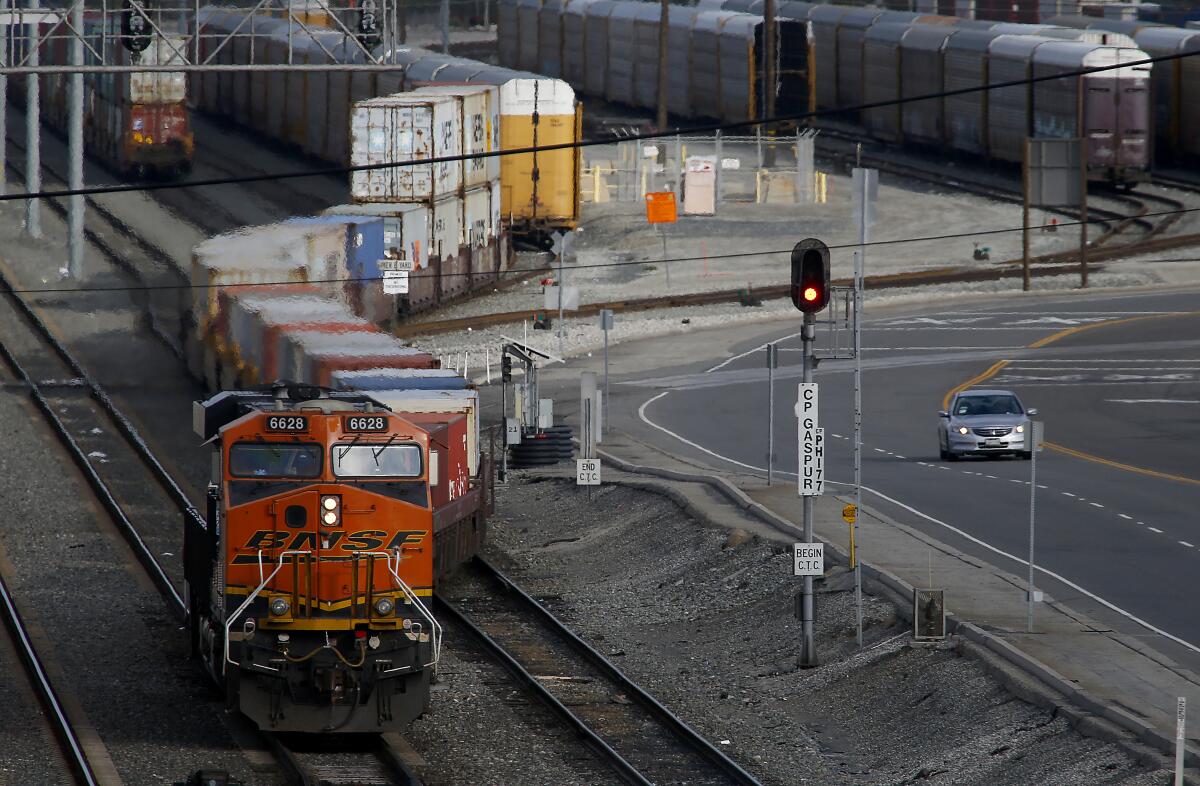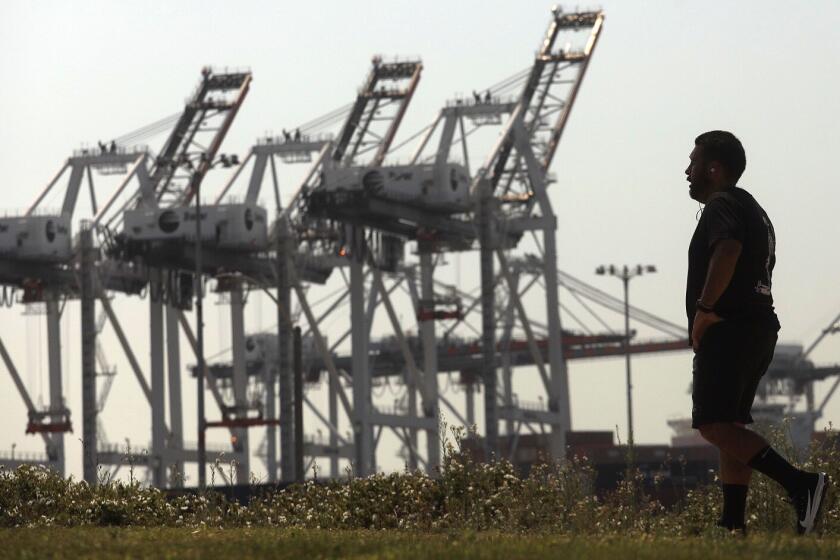How to end SoCal’s smog streak? Slash pollution from railways and ports

- Share via
Southern California is in the midst of a smog streak, with more than 50 straight days of air pollution so bad it violates federal health standards. The last day with acceptable air quality was June 9.
A big reason the air remains so dirty in the region is that regulators haven’t acted to clean up rail yards and ports where droves of soot-spewing diesel trucks, trains and ships move cargo in and out. That’s why it’s a relief that the South Coast Air Quality Management District adopted rules Friday to force the region’s rail yards to cut pollution, most of which are concentrated in economically disadvantaged communities in the harbor area, southeast L.A. County and the Inland Empire.
It should have happened sooner. The 25 rail yards subject to the new pollution rules are responsible for about 9% of the region’s smog-forming emissions. For decades air quality officials have been aware that the heavy concentration of polluting vehicles and cargo-handling equipment serving rail yards is hurting people in neighboring communities such as Commerce and San Bernardino, contributing to higher asthma rates and cancer risk. Old locomotives that spew diesel exhaust into these communities at all hours are particularly gross polluters, and cleaning them up is long overdue.
The idea of an air-conditioning-free Summer Olympics in Paris may have been well intentioned, but ultimately focuses on the wrong things.
These aren’t the toughest rules regulators could have imposed, but will help clear Southern California smog faster and prevent an estimated 7,000 early deaths and more than 40,000 emergency room and hospital visits over the next two decades. They’ll do so by requiring that each rail yard meet emission reduction targets so the region gets its fair share of the benefits from existing statewide rules to phase out old, dirty trains and trucks with newer, cleaner versions, and by forcing them to draft plans for the chargers and grid upgrades needed to support electric vehicles and equipment.
That’s a significant gain, especially after last year, when AQMD officials considered abandoning the rules to instead cut a deal with BNSF Railway and Union Pacific. The negotiations wasted months and went nowhere, and that should serve as a reminder to air quality officials that their success comes from making rules, not striking deals.
Editorial: Trump and oil companies are lying to you about electric cars to serve their own interests
There is no federal ban on gas-powered cars. Trump and the oil companies are pushing that lie for their own self-serving agendas.
There are likely to be challenges to the new rules from the railroad industry, which has used its legal and lobbying clout to evade environmental regulations and has sued to block state rules on locomotive pollution, on which the AQMD rules depend. The air district’s last attempt to limit pollution from idling locomotives nearly 20 years ago was struck down after being challenged by the industry.
Next, Southern California’s smog regulators should turn their attention to the Los Angeles-Long Beach port complex, the region’s largest single source of smog-forming pollution. For years, the city-controlled ports have managed to fight off efforts to force them to cut their emissions, and the air district wasted years in fruitless negotiations and needless delays.
Southern California air quality officials discussed port pollution at a luxury Rancho Mirage resort 100 miles from the harbor, when they should be adopting long-delaying rules for L.A. and Long Beach ports to slash health-damaging emissions.
Here’s an example. In May, AQMD board members held a retreat to discuss port pollution at a Rancho Mirage resort, where they took no action but committed to adopting an emissions rule by the end of the year. That’s already been pushed back, with air district staff now saying they won’t have proposed rules ready for a board vote until early next year.
This is infuriating. No more delays — it’s time to get this done. If regulators can successfully impose smog-cutting rules on private industry, including warehouse distribution centers and railroads, surely they can do the same for the publicly owned ports of L.A. and Long Beach.
The people of Southern California, and their lungs, deserve nothing less.
More to Read
Updates
3:37 p.m. Aug. 2, 2024: This story was updated to reflect the air-quality board’s vote Friday to adopt the railyard rules.
A cure for the common opinion
Get thought-provoking perspectives with our weekly newsletter.
You may occasionally receive promotional content from the Los Angeles Times.









